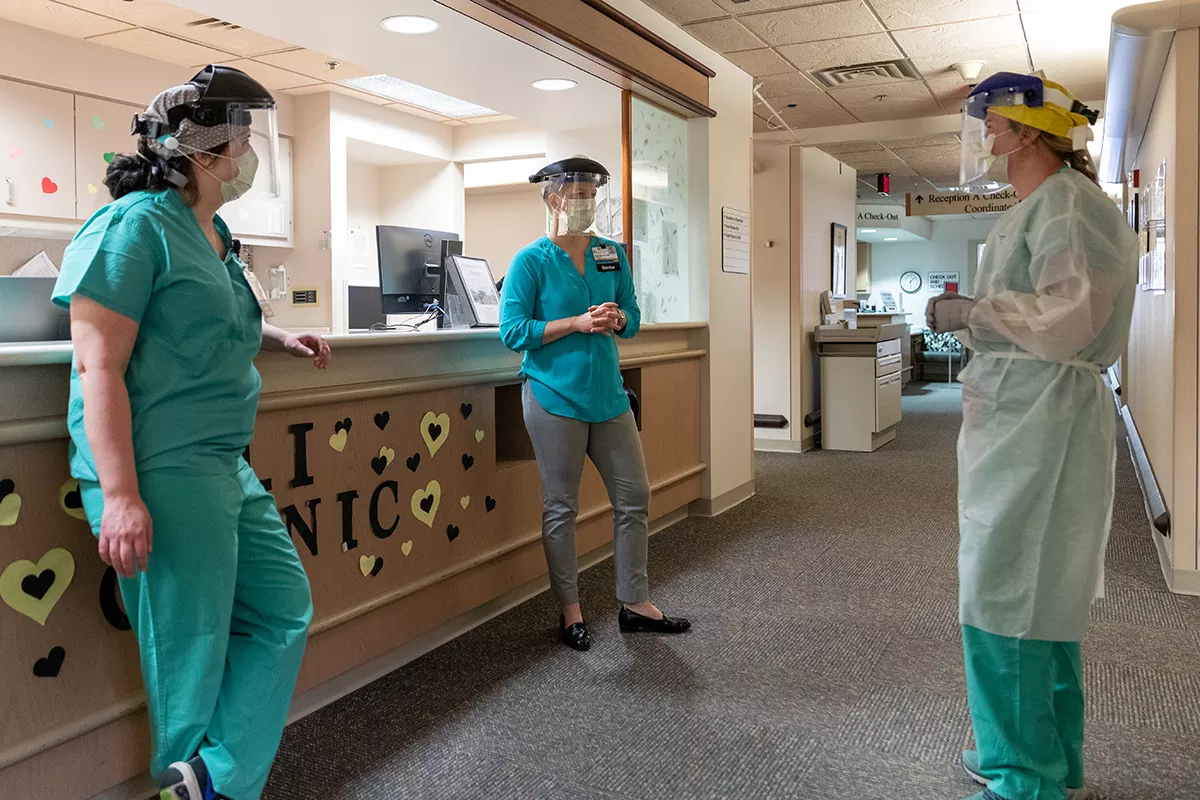Imborek heads effort to bring video visits, specialized clinic to early COVID-19 response at UI Hospitals & Clinics

Katie Imborek knows the number of reported cases of COVID-19 in Iowa. She also knows the state’s total number of patients with the disease is probably much higher.
“There are about 1,200 patients we’ve seen who were not tested for COVID, but had symptoms highly suggestive of having the virus,” says Imborek, MD, director of offsite primary care for University of Iowa Health Care. Early criteria surrounding the test was limited to only those who had traveled abroad or who had contact with those people, and not everyone met that criteria. “Though there is no way of ever knowing whether these patients actually had COVID, we knew the right thing to do for them was to follow them closely and manage them as if they did have it.”
By treating those untested patients as though they were COVID-positive, Imborek believes her team has helped keep the number of patients needing hospitalization relatively low.
Such results have been possible with the use of telemedicine and a designated respiratory illnesses clinic—conceived, planned, and launched in less than a week—as well as regular follow-ups with the patients who are sent home. Imborek was instrumental in the development and delivery of these services.
Early concerns
A little more than a month after the first U.S. patient was diagnosed with coronavirus in Washington state on Jan. 21, and a few weeks after University of Iowa Health Care leaders activated the Bio-Emergency Response Team (BERT), Imborek started to really get concerned about the disease and its potential impact on Iowa.
“It was Feb. 29—that night we had a holiday party for our unit—and I had listened to the New York Times podcast about the coronavirus,” says Imborek. “This guy was saying how it was similar to the Spanish flu (which killed an estimated 675,000 people in the U.S. in 1918), and I got really freaked out.”
She imagined those potentially infected with COVID-19 coming into full waiting rooms in our Quick Care and Urgent Care Clinics and spreading the disease to those with other health care needs.
Imborek talked to colleague Beth Jaggers, director of clinical functions of UI Physicians, about separating potential COVID-positive patients from other patients and keeping them isolated from crowded waiting rooms. Prompted by Denise Martinez, MD, who suggested that “now may be the time for telemedicine,” the two discussed the possibility of implementing —video visits between patients and clinicians to discuss symptoms, which would allow patients to stay in their homes.
The two, together with Rachel Kirchner, assistant director UI Community Clinics, and Debbie Herold, associate director of nursing UI Community Clinics, presented a proposal to BERT leadership during an ad-hoc meeting on March 4. Part of the plan included the development of a designated respiratory illness clinic that would test and potentially treat patients with COVID-19. Many were excited about the idea, Imborek says, “but it wasn’t something we as an institution had ever really done.”
Just six days later, UI Hospitals & Clinics held its first video visit for a patient with flu-like symptoms, similar to those seen with COVID-19.
Impact
With the implementation of “video visits” on March 10—just two days after the first cases were diagnosed in Iowa—Imborek and her team were able to connect with suspected COVID-19 patients via a web-based interface.
The Respiratory Clinic itself opened two days later, on March 12, providing an isolated area that served only those who were instructed to come in for a COVID-19 test.
Many of the estimated 1,200 potentially positive COVID cases came in the early days of the disease’s presence in Iowa. The first in the state were diagnosed March 8 in Johnson County at a time when restrictions on who could be tested were tight; tests were to be used on those who had traveled to or from certain parts of the world or who thought they’d come into contact with someone who had traveled overseas.
“In the very beginning, the State Hygienic Lab was doing all of the testing, and test capacity was an issue,” Imborek says. “We were following test criteria set out by the Iowa Department of Public Health, and for many of those patients—even though they had COVID-like symptoms—they didn’t meet that criteria.”
Once tests were developed by and made available through the UI Department of pathology, testing capability widened.
“University of Iowa Hospitals & Clinics has been above the curve with regard to our test capacity and turn around. Because of this we have been able to use more inclusive criteria resulting in increased number of patients tested,” she says.
By the numbers
As of April 22, the respiratory illness clinic has seen 6,402 patients believed to have COVID-19. Of those, 1,601 were tested for the disease—just over 300 tested positive.
There were 4,801 patients who were not tested, Imborek says, and about 1,200 of those patients were seen in repeat visits and ultimately followed and managed as though they were potentially COVID-positive. Those patients received an average of three follow-up telemedicine visits (video or phone)from providers over a seven-day period, which Imborek says was key in keeping them on the road to recovery and decreasing potential transmission of the virus to others.
“If there was concern for worsening shortness of breath, fatigue, or dehydration, we would have them come into the Respiratory Clinic for an in-person evaluation with a provider which might include laboratory testing, chest x-ray, and/or IV fluids or other treatments she says. “Some patients did get sicker, but most were able to stay home and recover without needing to go to the emergency department.”